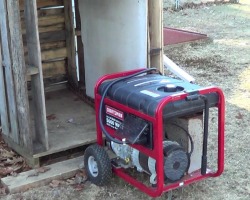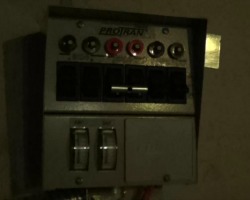In a recent article on SHTFBlog called “10 Lessons From A Multi-Day Power Outage“, I fielded several questions about how my generator was set up for a power outage, so I thought I’d walk you through what I’ve done with my back up generator. You’ll need a few things and they aren’t cheap; however, if your power goes out with any regularity, or you have young kids, or you just want to be comfortable if it does go out, you might want to invest in these items. I also want to point out that this is not a long term SHTF solution to a grid down situation. This particular solution is designed for a few days to a couple of weeks of use.
generator was set up for a power outage, so I thought I’d walk you through what I’ve done with my back up generator. You’ll need a few things and they aren’t cheap; however, if your power goes out with any regularity, or you have young kids, or you just want to be comfortable if it does go out, you might want to invest in these items. I also want to point out that this is not a long term SHTF solution to a grid down situation. This particular solution is designed for a few days to a couple of weeks of use.
By Jarhead Survivor, a contributing author SHTFBlog & Survival Cache
It depends on how much fuel you have stored for your generator and how long it will run before breaking down. It could be used for a longer duration if necessary, but the generator would take a lot of use and abuse over this amount of time and you’d have to make sure you changed the oil and whatever else was needed for maintenance for your particular unit. Items you’ll need: generator; a transfer switch; and a cable to connect the generator to the transfer switch outlet. I wrote an article about this awhile back, but I had just installed everything and hadn’t really had a chance to use it. Now I’ve got some experience with this set up and the generator house has been built (Click Here).
Why a Transfer Switch?
You don’t necessarily need a transfer switch to run your generator. When I bought my first generator about five years ago I  just ran some extension cords in through a window and hooked the things I wanted to run up to it that way. For example: I ran one long cord in and used it to connect my refrigerator and freezer up, so I wouldn’t lose any food. Then I used another cable to hook up lights, the TV and DVD player for the kids, and a few other odds and ends. It works OK, but things like the water pump and furnace wouldn’t run. I also wound up with a pile of electric cords running all over the place.
just ran some extension cords in through a window and hooked the things I wanted to run up to it that way. For example: I ran one long cord in and used it to connect my refrigerator and freezer up, so I wouldn’t lose any food. Then I used another cable to hook up lights, the TV and DVD player for the kids, and a few other odds and ends. It works OK, but things like the water pump and furnace wouldn’t run. I also wound up with a pile of electric cords running all over the place.
 The transfer switch is used when the power goes down and it allows certain items or zones in the house to run. It looks much like your fuse box, but is connected directly to the generator through an outside receptacle. With the transfer switch I can run the furnace, water pump (220 v), and certain portions of the house without having to run any extension cords into the house. It’s more expensive to do it this way, but far easier and you get a few things like the water pump you wouldn’t necessarily get using just the extension cords. If you’re good with wiring you might be able to hook it up yourself, but I hired an electrician to come in and do it right. That way I know it’s done right and when we flipped the switch over the first time I wasn’t scared of my house burning down.
The transfer switch is used when the power goes down and it allows certain items or zones in the house to run. It looks much like your fuse box, but is connected directly to the generator through an outside receptacle. With the transfer switch I can run the furnace, water pump (220 v), and certain portions of the house without having to run any extension cords into the house. It’s more expensive to do it this way, but far easier and you get a few things like the water pump you wouldn’t necessarily get using just the extension cords. If you’re good with wiring you might be able to hook it up yourself, but I hired an electrician to come in and do it right. That way I know it’s done right and when we flipped the switch over the first time I wasn’t scared of my house burning down.
4 Rules For Generator Placement
There are four things you’ll need to worry about when choosing a location for you generator:
1st – Carbon Monoxide: Make sure your generator is at least 15 feet away from your house or open windows. Check the ordinances in your state as it might be different where you live. My generator sits close to the house, but there are no windows or places for the gas to enter on that side of the house.
2nd – Noise: They can be fairly noisy and after a few days the constant droning might start to drive you a little crazy, especially if you have it close to your main living space. Mine is placed around the back of the house and this helps keep the noise down.
3rd – The Cable: Make sure your cable is long enough to reach the receptacle on the side of the house from where your generator sits. This is usually a 220 volt line, so it’s not like you can just plug in an extension cord!
4th – Shelter: If this is an extended period or long term storage you might want to consider building a small generator housing for it to keep the weather off. I used pallets and some cement board to build mine. I’ll detail this out in my video below.
The Video
Do you have to set yours up exactly the same way as mine? Of course not. Figure out what your electrical needs are and build a system for it. My mother-in-law has a large propane unit that kicks on automatically and runs the whole house. Since I didn’t have $10,000 to throw at a system I went with something a lot smaller, but still effective for me.
Questions? Comments?
Sound off below!
by Jarhead Survivor




